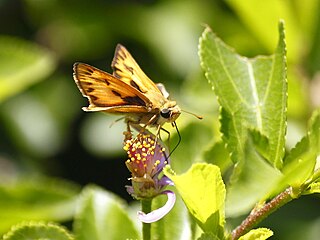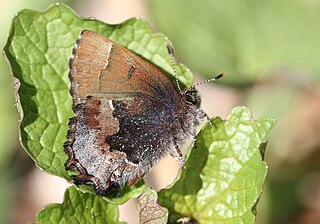
Grass skippers or banded skippers are butterflies of the subfamily Hesperiinae, part of the skipper family, Hesperiidae. The subfamily was established by Pierre André Latreille in 1809.

The Zabulon skipper is a North American butterfly first described by the French naturalists Jean Baptiste Boisduval and John Eatton Le Conte from the state of Georgia, United States.

Atalopedes campestris is a small grass skipper butterfly. It has a wingspan of 35–41 mm. Male is orange, edged with brown, and has a large brown-black stigma. Female is darker with lighter markings in the center of the wing.

The fiery skipper is a species of butterfly in the family Hesperiidae. Reaching approximately 1 inch (2.5 cm) in length, male fiery skippers are orange or yellow while the females are dark brown. Small brown spots may be observed on both the hindwing and forewing of both sexes although to a varying degree. Females may be darker brown overall with pale checkered markings on the hindwing. Fiery skipper larvae, or caterpillars, are greenish pink-grey with a black head and constricted neck. These larvae are often considered pests and can feed on Bermudagrass, creeping bentgrass, and St. Augustine grass.

Epargyreus clarus, the silver-spotted skipper, is a butterfly of the family Hesperiidae. It is claimed to be the most recognized skipper in North America. E. clarus occurs in fields, gardens, and at forest edges and ranges from southern Canada throughout most of the United States to northern Mexico, but is absent in the Great Basin and western Texas.

Burnsius communis, the common checkered-skipper, formerly known as Pyrgus communis, is a species of butterfly in the family Hesperiidae. It is known as the frequently seen Pyrginae species in the northern United States by collectors and watchers alike.

Papilio canadensis, the Canadian tiger swallowtail, is a species of butterfly in the family Papilionidae. It was once classified as a subspecies of Papilio glaucus.

Telegonus cellus, the golden banded-skipper, is a North and Central American species of butterfly in the family Hesperiidae. There are two populations, one in the eastern United States and the other in the southwestern United States and Mexico. The eastern population is rare and local and uses only one host plant, the thicket bean. The southwestern population is uncommon to common and uses more than one host plant. The golden banded-skipper is most active mid-morning and late afternoon. Their flight is sluggish and low to the ground, compared to closely related species.

Ancyloxypha numitor, the least skipper, is a North American butterfly in the family Hesperiidae. They have a weak, Satyrinae-like flight.

Polites themistocles, the tawny-edged skipper, is a North American butterfly in the family Hesperiidae.

Callophrys henrici, the Henry's elfin or woodland elfin, is a North American butterfly in the family Lycaenidae. In Canada it is found from southern Manitoba to southern Nova Scotia. It has two main groups of populations in the United States; the first is found along the Atlantic Coast and uses various hollies (Ilex) as host plants; and the second is found mainly in the north and the Appalachians where they use redbud as a host plant. Henry's elfin is increasing in New England because of an introduced buckthorn it now uses as a host plant. It is listed as a species of special concern in the US state of Connecticut.

Cecropterus is a genus of skippers in the family Hesperiidae, within which it is placed in subtribe Eudamina. It has three subgenera: Cecropterus, Thorybes and Murgaria.

Cecropterus dorantes, the lilac-banded longtail or Dorantes longtail, is a species of butterfly in the family Hesperiidae. It is found from Argentina, north through Central America, Mexico, and the West Indies to southern Texas and peninsular Florida. Strays can be found as far north as northern California, southern Arizona, southern Missouri and North Carolina.

Polites vibex, or the whirlabout, is a grass skipper in the family Hesperiidae. The whirlabout gets its name from the landing and take off flight patterns of the adult – a circular or vortex or whirling motion. It is resident from the southeastern U.S. and West Indies to eastern Mexico through the tropics down to Argentina. During the warmer North American months, it can sometimes be found as far north as Ohio, Connecticut, and northeast Iowa.
Cecropterus casica, the desert cloudywing, is a species of dicot skipper in the butterfly family Hesperiidae. It is found in Central America and North America.
















